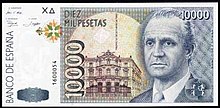peseta
| Peseta | |
|---|---|
| Country: |
|
| Subdivision: | 100 céntimos |
| ISO 4217 code : | ESP, ADP |
| Abbreviation: | Pts, pta |
|
Exchange rate : (fixed) |
EUR 1 = ESP 166.386 ESP |
The peseta ( German pesete ; plural: pesetas , Spanish pesetas , abbreviation: Pts; currency symbol : ₧; ISO code : ESP) was the official currency of Spain until the euro was introduced in 2002 . In addition, the peseta was recognized as valid currency in Andorra , as was the French franc .
Five pesetas, especially as a unit of coins in the form of a 5 pesetas coin, were called a duro in Spain until very recently .
designation
The name is usually understood as a derivative of the diminutive of the word peso ( Spanish "weight"), which is itself used as the name of some currencies . Peseta can also be derived from the Catalan word peceta (pronounced "peseta"), which means something like "small piece" (diminutive of peça ). In addition to linguistic reasons, there are also historical reasons in favor of the latter, as the first coins known as peseta come from Barcelona and the earliest word explanations in Spanish dictionaries of the 18th century also start from the word pieza (Spanish "piece") as a reference term ( la pieza que vale dos real , "piece worth two reals").
history
The first coins to be identified as pesetas were minted in Barcelona during the Napoleonic period between 1808 and 1814, the first coin with a value of one peseta dates from 1809.
The peseta was introduced as the reserve currency on October 19, 1868 as part of the currency reform of the Catalan Laureano Figuerola, who took office ten days earlier as finance minister of the revolutionary government under the reign of Serrano . The previous currencies, including the real and the escudo , were abolished and, for the first time in Spain, a pure decimal currency system was created that lasted until the euro was introduced. The new currency was integrated into the Latin Monetary Union that had been created a few years earlier , a peseta was initially exchangeable 1: 1 for a French franc and an Italian lira . Coins were initially issued for 1, 2, 5 and 10 céntimos in bronze and for 20 and 50 céntimos as well as for 1, 2 and 5 pesetas in silver. They show the seated España and the Spanish national coat of arms. In 1876 the first gold pesetas with a value of 10 and 25 pesetas appeared, later pieces of 20 and 100 pesetas in gold were added. Little changed in this system until the beginning of the Franco dictatorship.
After the Spanish Civil War , inflation began to rise and the peseta quickly lost value. Only coins in iron, brass or aluminum were issued instead of precious metals. As the country stabilized in the late 1950s, new coins of 10 and 50 céntimos in aluminum, one peseta in Nordic gold , 5, 25 and 50 pesetas in copper-nickel, and 100 pesetas in silver were issued. In 1933 a peseta was still worth 4.2 grams of silver; in 1966 it was only 0.15 grams, which corresponds to inflation by a factor of 28.
In the 1970s, inflation increased again, which is why new coins were introduced from 1975. Initially, the 100 pesetas silver coin was replaced by a 100 pesetas not made of precious metal. On the occasion of the Soccer World Cup in Spain in 1982 , the last 50 céntimos coin appeared in 1980. From the mid-1980s, corresponding coins replaced the 200 and 500 peseta notes, although the notes remained valid until the introduction of the euro. Finally, from 1991 a completely new set of coins was introduced (1, 5, 10, 25, 50 (called the Spanish flower ), 100, 200 and 500 pesetas), which was in circulation until the introduction of the euro in 2002, whereby the one now made of aluminum 1 peseta piece had largely disappeared from everyday life in the years before. From 1991 onwards, new banknotes were issued to replace the old series, whereby the issuance of 200 and 500 pesetas was dispensed with. This series was designed by Reinhold Gerstetter , the chief graphic designer at the German Federal Printing Office at the time .
With the introduction of the euro as the accounting unit on January 1, 1999, the official exchange rate was set at 1 € = 166.386 ₧.
The euro was introduced as a means of payment in Spain in 2002, replacing the peseta as the country's currency. Only the Spanish National Bank or some service providers change coins and notes from the former currency into euros after 2002. According to the National Bank, the exchange is possible until December 31, 2020.
In Andorra, too, the peseta (like the French franc) has been replaced by the euro as the official currency.
Web links
- Description of the Spanish banknotes and coins on the Banco de España website
- Historic banknotes of Spain
Individual evidence
- ↑ keyword peseta in the dictionary of the RAE .
-
↑ Keyword pesseta , in: Jesús Mestre i Campi, Josep Maria Salrach, Josep Termes: Diccionari d'Història de Catalunya , 1st edition, Edicions 62, Barcelona 1992, p. 815 f.
The spelling peceta follows the principles of modern Catalan spelling and is anachronistic here, since at the time the word peseta was created there was no Catalan spelling and the spelling peseta (or pesseta ) could be understood as a Spanish as well as a Catalan word. In modern Catalan, the pesete is called pesseta . - ↑ a b Keyword Peseta , in: Diccionario Etimológico español en línea. Santiago de Chile 2016, accessed July 2018.

